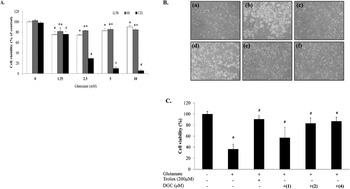Licorice, the root of the Glycyrrhiza species (Glycyrrhiza uralensis Fisher), is known to have antioxidant, anti-inflammatory, anti-viral, and anti-tumor properties( Reference Seo, Lee and Kim 1 , Reference Shibata 2 ). The objective of this study was to explore the neuroprotective effect of dehydroglyasperin C (DGC) against glutamate-induced oxidative stress in the mouse hippocampal HT22 cells. DGC significantly reduced cytotoxicity and reactive oxygen species (ROS) generation induced by glutamate in HT22 cells, whereas DGC did not restore glutathione depletion caused by glutamate. In addition, we investigated further whether DGC affected the expression of heme oxygenase (HO)-1, one of major cellular antioxidant defense systems, and found that DGC dose-dependently increased HO-1 expression. DGC-mediated cytoprotection of HT22 neuronal cells from glutamate insult was abrogated by either HO-1 inhibitor (Tin protoporphyrin, SnPP) or AKT inhibitor (LY294002). In conclusion, the present results demonstrate for the first time that DGC protects neuronal cells against glutamate-induced oxidative injury through the induction of HO-1 expression which is, in turn, activated maybe through Nrf2-Keap1 and PI3K/AKT signaling pathways.

Figure 1. Effect of glutamate, DGC, Trolox on proliferation of mouse neuroblastoma HT22 cells.
This work was supported by the National Research Foundation of Korea Grant funded by the Korean Government (MEST)” (NRF-2010-00272, 2011-0009782)



